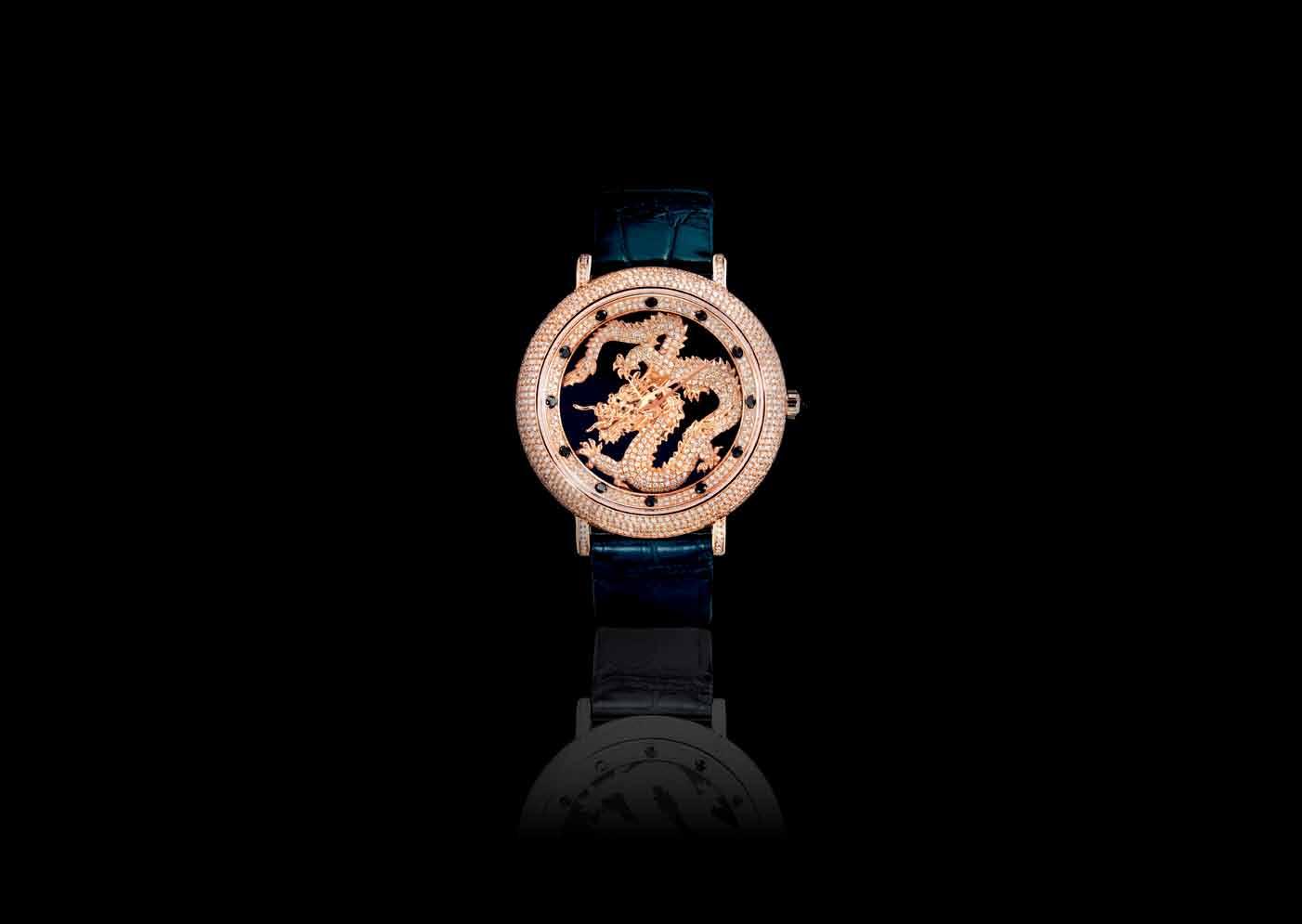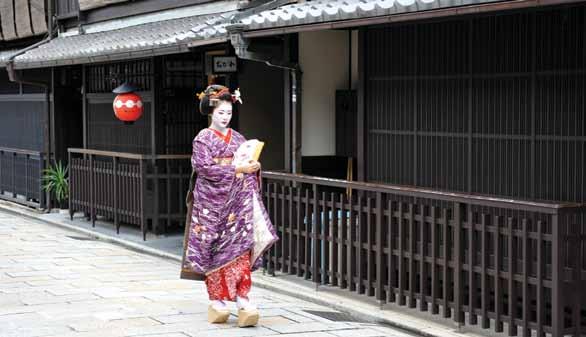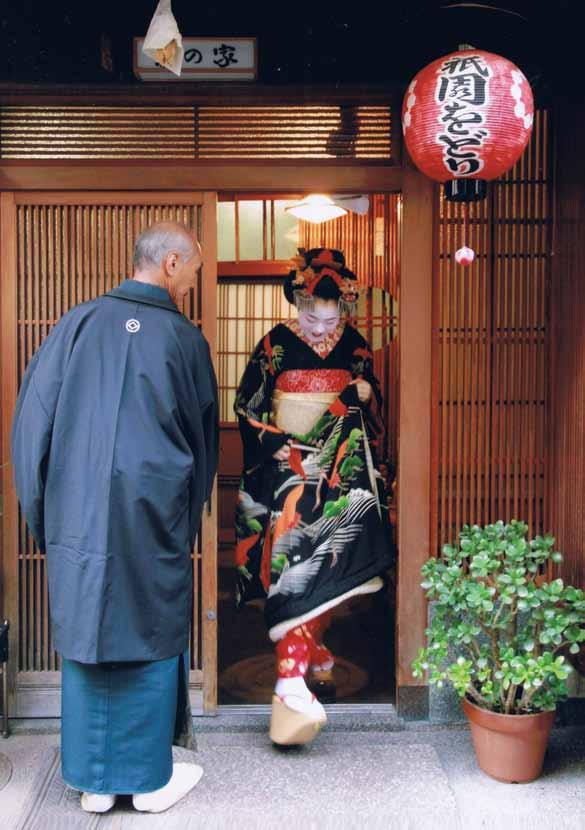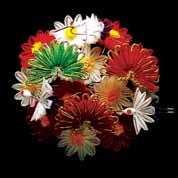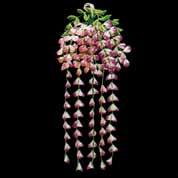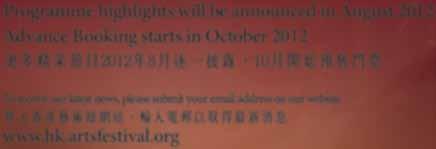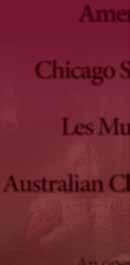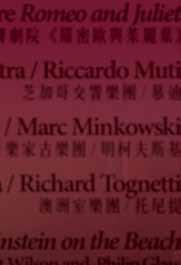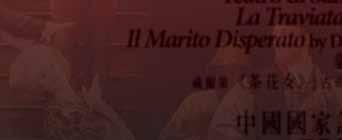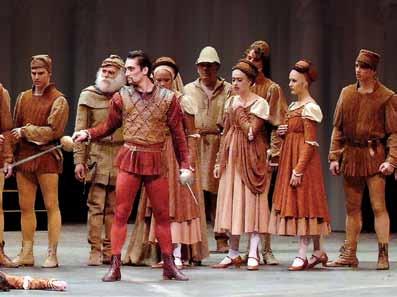精緻的藝妓飾物
Flower Hair Ornament with Exquisite Design
舞妓有幾件獨特的飾品,比如花簪及和服腰帶。她們每個月都佩戴具不同季節含義的 花簪。花簪完全是手工製作,將極纖薄的蟬翼紗仔細的漂染,再用刀切成兩公分闊的 方塊。手工技師將小方塊折成三角形作為花瓣,並將花瓣與絲線黏在一起,然後將所 有細小的部分組合成一個花簪。大的花簪大約有50個小花朵,需要經驗豐富的手工技
師花很長時間才能製成。祇園有一家五代都製作花簪的老店,自江戶時代就開始為藝 妓和舞妓服務。但如今很多年輕女孩都對這個特別的世界充滿興趣,繼承花簪手藝的 店主希望這門手工藝可以長久傳承下去,甚至達數百年之久。
There are several special accessories that are served only for Maiko such as Hana Kanzashi (flower hair ornament) and Pocchiri (Obi sash ornament). Maiko wear Kanzashi with different seasonal motifs each month. The entire making process of Hana Kanzashi is done by hand. Very thin silk organdie is dyed carefully and cut into squares (2cm) by a knife. The craftsman folds and shapes it to make triangles that take the shape of flower petals. He puts glue on the petal part and ties it with silk strings. Then he puts those small parts and other pieces together on one Kanzashi. As one big Kanzashi has about 50 small flower pieces, it takes a long time for skillful and experienced craftsmen to make this type of Kanzashi. An old shop in Gion has been making Hana Kanzashi for five generations. It started its business for Geiko and Maiko in the late Edo period, but nowadays, many young girls are interested in this special world, and the owner hopes that this tradition will last many years, even several hundred years.



花 Flowers:
新年:稻穗 New Year (rice ear)
一月:白菊、松樹和鶴望蘭 January (winter chrysanthemum, pine tree and crane)
二月:梅花 February (plum flower)
三月:油菜花/或「野歐白芥」 March (field mustard)
四月:櫻花 April (cherry blossom)
五月:紫藤 May (wisteria)
六月:柳樹和加羅林雪輪 June (willow tree and wild pink)
七月:日本扇 July (Japanese fan)
八月:芒花 August (silver grass)
九月:日本風鈴草 September (Japanese bellflower)
十月:菊花 October (chrysanthemum)
十一月:楓葉 November (maple leaf)
十二月:招財 December (maneki)
中譯:葛欣
藤間紋壽郎 編舞家
藤間紋壽郎於1921年出生,是文樂(日本傳統木偶劇)藝人桐竹紋十郎二世(國寶) 的長男。十六歲時矢志成為日本編舞家,拜初代藤間壽右衛門為師。二十歲時,獲藤 間勘右衛門三世(松本幸四郎七世)授名藤間紋壽郎。經過八年的兵役,於戰後拜師
藤間勘右衞門四世(尾上松綠二世),努力創作男性群舞。舞蹈會(紋壽郎之會)已 舉行20次以上,全國各地弟子演出的(藤紋會),直至今年為止在國立劇場已演出達 36次之多。從1960年開始在日本大學藝術學系的演劇學科任教,學生大都已成為現今
非常活躍的日本舞蹈家。另外,他從1962年開始擔任若草劇團的日本舞蹈講師至今。 1975年開始任職京都祇園東歌舞會的專任講師,亦擔當第二十一回祗園舞蹈表演的編 創工作。
Monjuro Fujima Choreographer
Fujima was born in 1921 as the eldest son of Monjuro Kiritake, puppeteer of Bunraku (a traditional Japanese puppet theatre), but instead of carrying on the historic family name, he set his mind on becoming a choreographer of Japanese dance. He entered the Fujima school at 16 years old and the head, Kanemon Fujima the Third permitted him to announce himself as Monjuro Fujima when he became 20 years old. After surviving World War II, he studied with the head, Kanemon Fujima the Fourth (legendary Kabuki actor, Shoroku Onoe the Second), and devoted himself to create gregarious male dances. He presented new dances at Monjuro no Kai (a dance club held by Fujima) more than 20 times, and with his followers from all over Japan has held a Japanese dance festival Tomon Kai at the National Theatre in Tokyo 36 times. Fujima has taught at Nippon University since 1960 and his students play an active part in the Japanese dance scene now. He is also an instructor of Japanese dance in the Wakakusa company. He became an exclusive Japanese dance instructor of Gion Higashi (East) Song and Dance Society in 1975, and has been choreographer of Geiko and Maiko in Gion Odori since 1977.

杵屋勝祿 長唄及三味線師匠
1949 年4 月24 日於大阪出生,是初代杵屋勝祿的第二子。孿 生兄長是唄方的杵屋東成二世 (杵屋祿三) 。長男是杵屋祿山 (三味線方) ,次男是杵屋祿丈 (唄方)。從幼年開始拜父親為 師。1953年,三歲便初登舞台(松坂屋Hall《紙人形》)。 從小學習日本舞蹈、鋼琴和聲樂。在1968年19歲的時候,獲 第七代杵屋勝三郎家元授名(杵屋祿宣)。1971,大阪追手 門學院大學文學部社會學系畢業,主辦《祿宣會》藉以培育 後繼者。
1967年於舊大阪朝日座的《歡進帳》中,為片岡仁左衛門兄弟初登歌舞伎的舞台。多 次參與歌舞伎的海外公演(1981年市川猿之助《黑塚》歐洲及美國巡演、1984年坂東 玉三郎《歌劇院百年祭》等)。
其後,主要為市川猿之助丈擔任歌舞伎舞的首席主唱者和三味線的首席彈奏者,並曾 多次參與NHK電視及電台等演出。2009年在第七代杵屋勝三郎家元的推舉下,襲名第 二代杵屋勝祿。
現任長唄三味線演奏家「祿生會」杵勝會理事、長唄協會所屬、日本舞踊西川流西川評 議員、大阪松竹座「上方歌舞伎塾」講師、京都祇園東藝妓組合之檢番長唄教師(負責 京都祇園舞的作曲)。曾獲1987年度 Sakuyakonohana獎(音樂部門「長唄.三味 線」) 及1987年度 Green Ribbon獎。
Katsuroku Kineya Master of Nagauta song and shamisen
Kineya was born as the second son of Katsuroku Kineya the First (a master Nagauta singer) in 1949. His twin brother, Tosei Kineya the Second, is also a singer of Nagauta. Katsuroku studied Nagauta with his father and made his debut on stage when he was three years old. He also studied Japanese dance, piano and voice culture. Katsuroku formed a group of Nagauta shamisen players as soon as he graduated from Ottemon Gakuen University in 1971, and now he is a leader of Rokusho kai.
Since 1967 when he appeared on Kanjincho (The Subscription List , a Japanese kabuki play) for Nizaemon Kataoka brothers. Katsuroku has been working as the lead shamisen player on various Kabuki productions both in Japan and abroad (such as the Europe and US tour of Kurokami by Ennosuke Ichikawa and 100th Year Festival of the Opera House by Tamasaburo Bando).
Katsuroku often holds recitals and appears on TV and radio programmes. He succeeded his late father’s name with a recommendation by Katsusaburo Kineya in 2009. Kineya is a director of Kinekatsukai and instructor of the Kamigata Kabuki school. He is an official teacher of the Gion Higashi Geiko Union and is responsible for composing Nagauta music for Gion Odori every year. He received the Green Ribbon award and Sakuya Conohana award in 1987.
節目一 Programme A
A-1 茂盛之松樹 All Sorts of Pine Trees
這是作者不詳的名曲。此曲描述日本各地與節慶有關的著名松樹,是源於京都一帶的 地方民謠,《大黑舞》。大黑舞是在室町時代(1338年至1573年)的習俗,在正月等 時候,大黑天(即財神)戴上帽子及面罩,前去逐家逐戶進行表演。在江戶時代,歌 曲深受老百姓歡迎,是備受雜耍場所廣泛採納之雜技舞蹈歌唱,也在花街被視為喜慶 的舞蹈。
The creator of this work is unknown. The piece enumerates the famous pine trees all over Japan associated with celebrations. It is a song of Daikoku mai, a custom from the Muromachi period (1338-1573) where performers in the costume of the God of Wealth (with cap and mask) went from house to house playing and singing. During the Edo period, the song became popular among common people, and while it was sung with acrobatic dance in vaudeville houses, it was also chosen as a celebration dance in flower districts.
A-2. 春雨 Spring Rain
此曲由原本在長崎學習神典歌道和禪學的肥前鍋島家臣柴田花守作詞,長崎藝者管理
所的師傅作曲,是在嘉永年間江戶流行的三味線小曲的代表作。三味線小曲是江戶時 代的流行曲,主要是描寫老百姓的生活、日常變化的情景、季節的轉變、江戶的風情 和微妙的內心世界等。在春季一個恬靜的下雨天,一隻黃鶯擱在一棵古老的梅花樹上
休憩歇息。梅花的清淡香氣四溢,黃鶯始終守候於同一棵梅花樹上。意指女子痴心等 待,期盼和情人共聚的一天來臨。
Hanamori Shibata, a clansman of the Bizen Nabeshima domain, wrote the lyrics, and a master of the Nagasaki flower district did the score. The piece is one of the most important works of Hauta that became popular in the Edo period around 1850.
Hauta depicts a variety of elements such as the lives of common people, daily and seasonal scenes, and niceties of the heart. It depicts a quiet rainy spring day, where a bush warbler is resting on an old Ume tree, where a scent of blossoms floats in the air. It is believed that a bush warbler always stays on the same Ume tree, much as a woman longs to live with her lover.
A-3. 京都之四季 Four Seasons of Kyoto
這是在江戶幕府末期,一首作者不詳、在京都大阪地區流行的三味線歌曲。三弦曲新 版是由村山亘和松島庄十郎合作而成。歌詞內容是描寫以祇園為中心,京都各個著名 景點的四季風情。如櫻花盛開的東、晚間納涼的鴨川、遍地紅葉的長樂寺和滿山飄雪 的 山。在京阪地區流行的三味線歌曲,伴奏充滿陽光氣息的開朗氛圍。優雅清新的 曲風、嫻熟的舞蹈技巧,把京都風情柔和地交織展現,也成為在宴會上極受歡迎的表 演樂曲。
A Kamigata (the western part of Japan) song from the end of the Edo period; Wataru Murakami and Shojuro Matsushima created the new Nagauta (long song) version. The lyrics mention famous places around Gion and the seasons they are associated with. The refrain is a specialty of the western part of Japan having a cheerful rhythmical effect. It is an elegant and lucid song, popular at banquets where elaborate Japanese dance techniques intermingle within a tender atmosphere richly imbued with the aura of Kyoto.
A-4. 黑髮 Black Hair
1784年初代櫻田治助作詞,初代杵屋佐吉作曲的三弦曲。
櫻田治助(1734年—1806年)在1769年獲第四代市川團十郎提拔為大劇團的作家, 江戶歌舞妓的世相狂言得以確立(世相狂言是歌舞妓中一個描寫時代生活的劇種)。 初代杵屋佐吉(出生年份不詳-1807年)於1778年中村座演奏《朦朧的月亮》三味線 外,其後亦寫了許多大薩摩曲。
黑髮是Meriyasu(歌舞妓中表達深深思念和哀愁等靜態情景時,提昇抒情效果的背景 音樂)的代表作。天明四年 (1784年) 在初演《大商蛙小島》中,描述辰姬在二樓遇上 政子,但政子卻邂逅了他的愛妻時,藉梳理秀髮等動作來表達強忍心中的情緒。
有別於戲劇,在地歌舞(在京都一帶盛行的一種舞蹈,又名京舞)中的內容是描述一 個女子在寧靜的早上,靜眺紛飛白雪,暗喻愛情的孤寂無奈。
在祇園,當舞妓成為藝妓的兩星期前,需要梳上一個名為「先笄」(Sakko) 的特別髮 型。在習俗裏,她會在這段期間跳這首名為《黑髮》的地歌舞。
This Nagauta was written in 1784, with lyrics by Jisuke Sakurada the First and music by Sakichi Kineya the First.
Jisuke Sakurada the First (1734-1806) was selected as the dramatist of a large Kabuki company led by Danjuro Ichikawa the Fourth in 1769, and he established the genre of dramas of manners (contemporary life) in Edo Kabuki. Sakichi Kineya the First
(unknown-1807) became the lead Shamisen player of Oborozuki at Nakamuraza Theatre in 1778 and since then wrote and played many grand Satsuma pieces of Nagauta for Kabuki.
Kurokami (Black Hair) is one of the most important works of Meriyasu (while actors express deep thoughts, anxiety and grief silently, musical accompanists build the emotional effects) that was played at the first performance of Ooakinai Kaerukojima. In the scene, Princess Tatsuhime combs her hair in sorrow of her secret love for Yoritomo who is meeting his wife Masako upstairs.
Later on, when the piece was arranged to Jiuta (a style of Japanese traditional music), the piece expressed the bitterness of love and pangs of solitude, and showed the resignation of a woman who was looking at the falling pure snow in the morning.
In Gion, a Maiko dresses a special hair style called Sakko only two weeks before changing to Geiko. There is a custom that she dances Kurokami (the Jiuta version was written by Ichijuro Koide) during this period.
5. 五條橋 Bridge of Gojo
由十三代杵屋六左衛門 (1870-1940) 作曲,約於1903年寫的作品。
《勸進帳》是歌舞妓中的有名劇目,內容是描述源義經和兄長賴朝(1192年鎌倉幕府
的初代將軍)不和,在逃往陸奧地區途中,於安宅(石川縣小松市西部)的關卡行將 被補時,被家臣弁慶營救而成功逃脫的情景。這二人初遇的地方就是京都的五條橋。
牛若丸(義經的幼名)與為求合乎源氏伙伴的強者身份而徘徊在京都街道上的弁慶, 在五條橋上對戰起來。最後,弁慶戰敗而終於成為牛若丸最忠心的家臣。而這段軼事 也成為文樂的劇目。在三弦曲中則是一首描寫牛若丸和弁慶對戰情景的激動人心歌 曲。
Rokuzaemon Kineya XIII (1870-1940) wrote the music around 1903. The piece is a part of a Japanese epic about Yoshitsune, a younger brother of Yoritomo Minamoto who established the seat of shogunate in 1192. The famous Kabuki play Kanjincho is a story about the relationship of lord and vassal, where Benkei saves Yoshitsune after falling out with Yoritomo. Gojobashi (Bridge of Gojo) is the episode about their first encounter. Ushiwakamaru (childhood name of Yoshitsune) was seeking strong men who were worthy to be warriors of the Minamoto family. Benkei was to collect 1,000 swords by thrashing warriors. They met and fought on the bridge of Gojo in Kyoto and as Yoshitsune won, Benkei became the most faithful vassal. The Nagauta version depicts their fighting with a very stirring melody.
節目二 Programme B
B-1. 三座神社之女 Ladies at Three Shrines
雖然作者不詳,但這是根據能劇中的《翁》而作的,也是神社表演的著名供奉舞蹈。
三社是指伊勢神宮、奈良春日大社和石清水八幡宮。在江戶時代,往這三神社參拜是 很流行的。這是作為天下太平,五穀豐收和繁榮安盛的祝賀歌曲。另外在正月、上屋 樑儀式和舞台開幕等時期也會作表演。小道具就是巫女跳神樂舞時手持的鈴(棒子上
部三段附着十五個響鈴)。歌曲以三降調表達出神社的熱鬧氣氛,是充滿節奏感的樂 曲。
Although the writer of lyrics and music is unknown, this piece is based on the Okina category of Noh plays and is famous as a dedicatory dance at shrines. Sanja means Ise Jingu in the Mie prefecture, Kasuga Taisha in the Nara prefecture and Iwashimizu Hachimangu in the Kyoto prefecture. The pilgrimage to these three shrines was popular in the Edo period.
As a ritual song to celebrate universal peace, a huge harvest and prosperity for a thousand years, it is played at the New Year, and framework raising and opening ceremony days. Mikosuzu (Special props) is an instrument with about 15 small bells attached to three rings on a stick with handle, which is used when shrine maidens dance a Kagura (a specific type of Shinto theatrical dance).
The music is tuned to three down beats and is rhythmical, to convey a bustling feeling .
B-2. 五萬石 Prosperous Domains
這首愛知縣民謠源自江戶時代,內容是描寫岡崎氏族的昌盛景況。石是意味封地,五 萬石(一石約為180 公升,五萬石即九百萬公升)雖然不是那麼大,但它是岡崎城德 川家康的誕生地,亦是德川氏在三河最重要的海上運輸樞紐。歌詞有許多不同版本, 這版本是把詞改編為歌詠,頌揚若松城的繁榮昌盛。
This folk music of the Aichi prefecture has carried on since the Edo period, which talks about the flourishing of the Okazaki domain. Gomangoku (9 million litres) meant the amount of fief that one feudal lord held.
Although a fief with 9 million litres of rice is not so large, Okazaki castle was where Leyasu Tokugawa (the founder of the Tokugawa shogunate) was born and the town was a most important base for ocean transportation in the Central part of Japan.
As there are many different versions of lyrics, the folk music of the Fukushima prefecture is chosen as the second verse that encourages the prosperity of the Wakamatsu domain.
B-3. 祇園小唄 Ballad of Gion
此作品為1930年《祗園小唄繪日傘》的主題曲,由原作小說的作者長田幹彥作詞,淺 草歌舞劇作曲家佐佐紅華作曲,是代表京都情懷豐富的歌曲,配合着祇園界隈(繁華 街)的四季變更,流露舞妓的戀情進展。在五花街的舞蹈流派各異,在每年一次由京 都傳統妓藝振興財團舉辦的《都之繁盛》表演中,二十名舞妓共聚一堂,每四名一組 共分成五組別,各自表演不同的舞姿供人觀賞。
When a film trilogy (Gion, Kouta, Painted Parasol) was made in 1930, Mikihiko Nagata, the author of its original novel, also wrote the lyrics of Ballad of Gion and Kouka Sasa who was popular as the composer of Asakusa Opera wrote the music for it. This piece is most notable among the songs depicting Kyoto for its richly emotional humanity. Harmonising with the turning of four seasons, Maiko’s affection is built up. Maiko in each of the five flower quarters take lessons on Japanese dance from different schools. Gion Kouta is performed only once a year when Ookini zaidan present a Miyako no Nigiwai, where 20 Maiko (four from each quarter) dance in five different styles.
B-5. 鷺娘 Maiden of Snowy Heron
《鷺娘》由富士田吉次及杵屋忠次郎作曲,是一首經典的降三調長唄。據說由作家壕越 二三治作詞,在1762年4月的江戶(東京)市村座川菊之丞初演,在明治時代的第九代 市川團十郎重演,根據基礎重新結構而成,是歌舞妓的代表劇目。現代版本由坂東玉 三郎反串主演,他的女性造型,富有超然美感。舞蹈裏的極速換衣過程,也是極其吸 引觀眾的看點。
白雪紛飛,在荒涼的原野上,白鷺幻化成漂亮的姑娘,深陷於人類的愛情難以自拔; 最後變回白鷺時,因成為獵物受創而最終氣絕身亡。白鷺受到地獄之神的種種折磨, 成就了凄美絕倫的故事。而《鷺娘》亦經常與芭蕾舞劇目《天鵝湖》互相媲美。
清澈而充滿幻想的序曲曲調,是華麗而感情豐富的 Kudoki (表現女性活躍心情的舞 蹈)。最後,把對女性的命運以哲學表現,譜出名為 Kurui(意思是瘋狂,在能劇和 歌舞妓中,用作表現情緒激動的舞蹈)的淒豔劇烈終章。
Maiden of Snowy Heron is a magnum opus of Nagauta, the lyricist is unknown, but it might be Nisoji Horikoshi (a playwright for Kabuki in the Edo period), and the music is by Kichiji Fujita and Chujiro Kineya.
真葛ヶ原に
そよそよと 秋は
色ます 華頂山
時雨をいとう から傘の
濡れ濡れて 紅葉の 長楽寺
思いぞ 積もる
円山に 今朝も 来て見る
雪見酒 エエ そして 櫓の さし向かい よいよい よいよい よいやさ
微風輕拂真葛原
秋登華頂山
油傘避雨灑
遍地紅葉長樂寺
滿懷思念情深
今朝重臨 山公園
高樓對座,賞雪品酒
The wind blows gently at Makuzugahara field, and Kachozan hills are covered in autumn foliage.
Shunning the shower with a bamboo-andpaper umbrella, (I see) red leaves are wet in Chorakuji temple.
I come to see (the snow) in the morning at Maruyama park that is piling up like my thought. I drink sake while watching the snow fall and (talk) face to face at Yagura (Kotatsu table). Everything is good, good, and good.
畳み重ねて打つ太刀に さしもの弁慶あしらひかね、 橋桁二三間飛びしきり、 走りかかって丁と切れば、 そむけて右に飛違ふ 取直して裾を薙ぎはらへば、 躍り上って足もためず 宙を拂へば頭を地に付け、 千々に戦ふ其有様、 目にもたまらぬ電光石火、 げに鬼神も及びなき、 勇ましかりける次第なり
弁慶繼而沖着刺向牛若丸 牛若丸彎下身閃向右方 弁慶取回平衡後再刺向 牛若丸的腿 牛若丸躍上欄杆 弁慶只誤中空氣 牛若丸再蹲伏地上 兩人於激戰中流露的勇氣 連魔鬼與神明也難於媲美
Even such a strong Benkei can’t handle and jumps back for about 4-5m. Then, Benkei runs to Ushiwaka and brings the spear down, but Ushiwaka ducks and flies to the right. Benkei holds his balance and mows down the spear at Ushiwaka’s feet, and he leaps up onto the parapet Benkei cuts across in the air and Ushiwaka crouches to the ground.
The spectacle of fighting is diverse, and is hard to watch, with its lightning-fast combinations.
Even a demon or god can’t compete, the two are really brave.
黑髮
黒髪の結ぼれたる
思いには解けて
寝た夜の 枕とて
独り寝る夜の 仇枕
袖は 片敷く 妻じゃと 云うて
愚痴な おなごの心も知らず しんと更けたる 鐘の声 ゆうべの夢の
今朝覚めて ゆかし懐かし
やるせなや
積もると知らで
積もる 白雪
五条橋
夫都大路を南北に、
貫き流る、加茂川に、
打ち渡したる五條橋
扨も源の牛若丸、
今宵も五條の橋に出で、
笛面白く吹き鳴らす
音も静かに更くるまま、
通る人をぞ待居たる
爰に西塔の武蔵坊弁慶は、
元より好む大長刀、
真中取って打ちかつぎ、
橋板荒かに踏みならし、
向ふをきっと打見やり、
夜更けて女性の立ったるは、
牛若は、薄衣引退け、
太刀抜放ち、
詰めつ開いつ戦ふうち
牛若手元に寄るぞと見 えしが、
黑髮
如黑髮般糾結的 疑慮已消除 與君共枕樂良宵
今夜獨枕倍孤單 君還訴說妻妾事 完全不解痴女心 傳來遠處寺院鐘聲 回想昨夜夢魂中
思念愁緒難消散 積雪不知情 但見憂愁 如雪堆
五條橋
五條橋架於加茂河川上 貫穿夫都大路南北
牛若丸今宵也來到五條橋 吹奏着笛子
靜靜地等待着 一位將要通過此處的人
西塔的武藏坊弁慶
平日最喜愛的大長劍 配戴身上
腳步重踏於橋上時 驟見一位女子
竟於深宵佇立於大橋上
牛若丸拋掉薄衣
拔出劍
與弁慶展開激戰
當牛若丸轉動利劍
強者如弁慶也難於招架
退避於數丈外
Black Hair
My thought like tangling black hair was unraveled and I slept well one night. but now I am alone and see even a pillow as my foe. You talked about your wife, without caring for my feelings. I heard the bell sound far into the night. Awakening from a dream of bygone days, I feel nostalgic and utterly miserable this morning.
My affection must grow without knowing it, as if the white snow stays quietly.
Bridge of Gojo
Bridge of Gojo is over River Kamo that extends North and South of the centre of the City.
Ushiwakamaru of Genji comes to the bridge of Gojo tonight again, and plays a flute intriguingly. He is waiting for a man passing by as the sound dissolves far into the night. Here, Benkei of Musashibo from the South tower carries a great spear on his back as usual. He stamps the bridge board loudly and sees a dubious woman standing on the bridge so late at night.
(when Benkei attacks with the spear,)
Ushiwaka throws off his light clothes and whips out a sword.
Ushiwaka and Benkei fight close to each other and place far apart.
When Ushiwaka takes continuous swings with his sword,
祇園東小唄
花の円山 石だたみ 桜吹雪に 舞衣 姿やさしき だらりの帯よ 祇園東に 祇園東に 灯がと もる
青柳ゆれる 鴨川に 祇園ばやしを 遠音にきいて 焦がれて 身を焼く 大文字 祇園東に 祇園東に 灯がと もる
まくづが原に 咲く萩や 桔梗花の しおらしさ 鳴いて君をば 松虫の 祇園東に 祇園東に 灯がと もる
雪の八坂に 思いぞつのる 鐘の響きも 新玉の よい事始めと 火縄舞う 祇園東に 祇園東に 灯がと もる
祇園東小唄 山公園花滿開, 悠悠石路 櫻花飄如雪,舞姿妙漫 長垂的腰帶 祇園東,祇園東,燈火通明
鴨川青、柳搖曳 輕輕傳來遠處祇園那邊 的聲音 情急如大文字山上的火焰 祇園東,祇園東,燈火通明
秋萩花滿開 桔梗花可愛 蟋蟀鳴叫 祇園東,祇園東,燈火通明
雪之八坂神社,思念倍增 鐘聲響,新年好事始 舞動火繩 祇園東,祇園東,燈火通明
Ballad of Gion East
Cherry blossoms in Maruyama park, petals falling in the wind are scattered on a stone pavement.
Wearing Kimono and a dangling Obi sash, the silhouette of Maiko is graceful.
The lanterns in Gion east now come on.
Green willows sway in the breeze at the bank of River Kamo.
Music of Gion festival is distantly heard. Ceremonial fires of Daimonji are burning ike someone's passion for her lover. The lanterns in Gion East now come on.
Japanese bush clovers and bellflowers blooming at Makuzugahara are very pretty. Crickets twitter that someone is awaiting you every moment.
The lanterns in Gion East now come on.
The snow lying on the roof of Yasaka shrine reminds one of accumulating feelings. The bell sounds expecting the start of the New Year at the year-end ceremony. People brandish a burning rope of a charm on New Year’s Eve.
The lanterns in Gion East now come on.
姬三社
やー おもしろのにぎわいて 神を勇めの 音もよや どんどと鳴るも 拍子よく 鳴ると鳴らぬは
袖振る 手拍子 そうじゃえ しめてしゃんとえ ゆるめて にこにこ おうよ 逢う夜 逢わぬ夜
神の昔は 二柱 天の 岩戸を開く 梅の見事え 花の盛りの しおらしや
五万石 五万石でも 岡崎様は アーヨイコノシャンセ お城下まで 船が着く ションガイナー アー ヤレコノ 船が着く お城下まで 船が着く ションガイナー ヨーイ ヨーイ ヨイコノシャンセ まだまだ はやそう めでた めでたの 若松様よ アー ヤレコノ 葉も繁る 枝も栄えて 葉も繁る オメデタヤー アー ヤレコノ 葉も繁る 枝も栄えて 葉も繁る オメデタヤー ヨーイ ヨーイ ヨイコノシャンセ まだまだ はやそう
祇園小唄
月は おぼろに 東 霞む 夜毎の かがり火に 夢も いざよう 紅ざくら しのぶ 思いを 振袖に 祇園恋しや だらりの帯よ
三座神殿之女
吔,氣氛鬧哄哄
振奮神明之聲
咚咚咚咚拍子響
鳴聲拂袖舞
言笑晏晏
拍手和應
啊~ 喲 ~ 啊
從前神明有兩位
岩戶花盛開
梅花綻開
姿妙漫 五萬石
就算只有五萬石之生產量
呀……哎吔﹗哎吔 岡崎市
船搖到城下
哎吔﹗哎吔﹗船到岸
船搖到城下,船到岸 哎吔,哎吔
喲 ~ 喲 ~ 喲
還未到呢
還早着呢
可喜可賀啊﹗可喜可賀之 若松市
呀唷,呀唷
枝葉繁茂地生長
可喜可賀啊
枝葉繁茂地生長
可喜可賀啊
喲 ~ 喲 ~
還未到呢,還早着呢
祇園小唄
朦朧的月兒在東面山邊
緩緩升起
晚霞紅紅似火
夜夜夢中紅櫻花盛開
思念之情隱藏長袖中 長垂的腰帶細數着祇園的 戀情
Ladies at Three Shrines
Yay, gloriously and prosperously, the sound of praising God is heard. With a bang, the rhythm is good. With leaps and bounds, swinging their sleeves, people clap in time. Yeah, let’s clap in unison, tightening and loosening beamingly. Oh, we should get into the rhythm. Ancient times of Gods, there were two columns and the rock gate was opened flourishingly. Japanese plum is marvelous, and the blossoms in full bloom are praiseworthy.
Prosperous Domains
Even the fief is only for 9 million litres rice, Lord Okazaki is magnificent.
Ships reach the bottom of the castle. Let’s applaud more and more.
With auspicious subjects, Lord Wakamatsu is excellent. The branches thrive and leaves grow thick.
Gion Kouta (Ballad of Gion)
[Spring]
The Moon is hazily seen at East Mountains
Every evening, ridgelines are blurred beyond the fire in iron baskets
Cherry blossoms, slightly tinged with rouge, beckon dreams
Maiko conceals her feelings in long-sleeved kimonos
People feel nostalgia for Gion and Maiko with long swaying Obi
夏は 河原の 夕涼み 白い 襟あし ぼんぼりに かくす 涙の
口紅も 燃えて身を焼く 大文字
祇園恋しや だらりの帯よ
鴨の 河原の 水やせて 咽ぶ 瀬音に 鐘の声 枯れた 柳に 秋風が 泣くよ 今宵も 夜もすが ら
祇園恋しや だらりの帯よ 雪は しとしと まる窓に つもる 逢瀬の さしむか い
灯影 つめたく 小夜ふけ て もやい 枕に 川千鳥 祇園恋しや だらりの帯よ
夏夜的河原,涼風輕吹 雪白的衣領上積累了
微塵
強忍心中淚水
艷麗的口紅,心中的熱情 如大文字山上
燃燒的火焰
長垂的腰帶細數着祇園的 戀情
鴨川河原的流水漸枯乾
流水聲嗚咽
似是和應神社的鐘聲 秋風輕吹殘柳 今夜淚濕到天明 長垂的腰帶細數着祇園的 戀情
圓窗外又見白雪紛飛 朝思夢想着的戀人對坐
燈影漸暗,寒夜漸深
兩人共寢鴛鴦枕
長垂的腰帶細數着祇園的 戀情
[Summer]
People enjoy the cool evening breeze at Kamo riverbank in summertime
Maiko with white nape hides her tears behind a paper shaded lamp
Her rouge is like the blaze of Daimonji which is as if burning the heart
People feel nostalgia for Gion and Maiko with long swaying Obi
[Autumn]
The current of Kamo River has shrunk
The bubbling of a brook is sorrowful like someone sobbing and a temple bell is heard
Autumn winds blow at the discoloured weeping willow this evening again
People feel nostalgia for Gion and Maiko with long swaying Obi
[Winter]
The snow gently falling can be seen through a round window
Maiko and I sit face to face at a meeting
We talk as the night wears on, under flickering light in the crisp air
While dozing like a moored boat, a song of the river plover is heard
People feel nostalgia for Gion and Maiko with long swaying Obi
鷺娘
妄執[もうしゅう]の 雲晴れやらぬ 朧夜[おぼろよ]の 恋に迷いし我が心
吹けども傘に雪もつて 積もる思ひは泡雪の 消えてはかなき恋路とや 濡れて雫[しずく]と消ゆ るもの
我は泪に乾く間も 袖干しあえぬ月影に
鷺娘
朦朧月色
執迷情愛之心
宛如迷離雲霧不散
清冽風雪掩蓋傘子
情濃似水,思念愛慕之情 如雪花
無情被瞬間溶化於空氣中 妾身肌膚盡濕透,如雪花 消失於無形 思念之情未盡 月影之下淚已乾
Maiden of Snowy Heron
As a cloud of obsession does not clear away in a hazy night, my mind is carried away by passion.
Snow covers my umbrella though the wind of love blows, telling my secret.
I wish my growing desire were transient and melted away like snow fall.
I am soaked to the skin and disappear like a snowflake.
I miss you desperately while my tears dry out in such a brightly moonlit night.
須磨の浦辺で汐汲 [しおく]むよりも 君の心がとりにくいさりと は
実に誠と思はんせ
しやほんにえ
添ふも添はれずあまつさえ
邪慳[じゃけん]の刃[やいば] に先立ちて
この世からさえ剣[つるぎ] の山
一樹[いちじゅ]の内に恐ろ しや
地獄のありさま ことごとく
罪を糺[ただ]して閻王[えん おう]の
鉄杖[てつじょう]まさにあり ありと
等活畜生[とうかつちくし ょう]
衆生地獄[しゅじょうじごく]
あるいは叫喚[きょうかん] 大叫喚[だいきょうかん]
修羅の太鼓は隙[ひま]もなく
獄卒四方[ごくそつよも]に群 [むら]がりて
鉄杖[てつじょう]振り上げ鉄 [くろがね]の
牙噛み鳴らし
ぼつ立てぼつ立て
二六時中[にろくじちゅう]が その間
くるりくるり追ひ廻[めぐ]り 追い廻り
終[つい]にこの身はひしひし ひし
憐れみたまえ
我が憂身[うきみ] 語るも泪[なみだ]なりけらし
進入君心比汲取
須磨海岸之水更難
妾心摯誠不變
白鷺振翅
雪花紛飛
美如花瓣散落空氣中
優雅地飄蕩着
未能與君結連理 君心冷若無情刀 但我倆仍處於同一樹下
就如地獄般恐怖
鐵杖揮舞 在地獄使者手中 嚴懲犯錯累累的妾身
畜生輪迴
凄厲呼喊
屠殺的太鼓聲響徹不止
獄吏驟從四方八面來
露出毒齒,揮舞着鐵杖 晝夜驅趕追捕
仇恨堆滿妾心
懇請憐憫痴情女
情愛迷惑人心
流著淚兒說故事
節目簡介、歌詞、簡歷中譯:李聖美
Entering into your feelings is more difficult than drawing salt water at the beach of Suma.
Yes, please take it seriously that I am truthful. Winning your heart is more difficult than pleating a satin skirt.
Yes, please take it seriously that I am truthful. Earnestly.
The air moved by wings of the white heron swirls up snow.
The scenery is like the flower petals fluttering down, but graciously snow falls, how lovely.
Besides that the bitterness of being unable to marry a loved one,
Before knowing his hard-heartedness which is like a blade,
A heap of swords falls on this life
Nevertheless we are under one tree by a turning fate, it is terrible
The state of hell extends to one and all.
The iron cane is now vividly seen, that the Ruler of Hell brandishes in order to punish for her sin.
Beasts of reincarnation, transmigration, all creatures in Hell, A scream, or great screams, a drum sound for carnage continues
Warders of Hell are coming from all directions.
They raise iron canes and bare their iron fangs.
Goading on and on, running in circles and in circles, chasing and chasing
In vain, the white heron tries hard
Finally feelings of hatred come through to my body loud and clear.
Please feel compassion on her who was carried away by love and passion. The story can’t be told without tears.
• 3 Hong Kong
• Acorn Design Ltd
• 泛聯展覽物流香港有限公司
Agility Fair & Events Logistics Ltd
• 香港法國文化協會 Alliance Française de Hong Kong
• 美國商會 American Chamber of Commerce
• The Antithesis
• Art Renewal Center
• 藝林文具印刷有限公司 The Artland Co Ltd
• 亞太表演藝術中心協會
Association of Asia Pacific Performing Arts Centres
• 亞洲演藝協會 Association of Asian Performing Arts Festivals
• 澳洲駐香港總領事館
Australian Consulate-General Hong Kong
• 樺利廣告有限公司 Avanny Advertising Co Ltd
• 亞域亞洲有限公司 Aves Asia Limited
• 龍堡國際 B P International
• BIS Records
• Bite Communications
• Boris & Matthew Ltd
• 法國巴黎銀行 BNP Paribas
• 英國駐香港總領事館
British Consulate General Hong Kong
• 英國文化協會 British Council
• 百老匯電影中心 Broadway Cinematheque
• 明愛白英奇賓館 Caritas Bianchi Lodge
• 香港明愛 Caritas-Hong Kong
• 國泰航空公司 Cathay Pacific Airways
• Mr T. K. Chan 陳德奇先生
• 嘉昱有限公司 Cheer Shine Enterprise Co., Ltd.
• Cherrypicks Ltd
• 張志偉 Mr Cheung Chi-wai
• 香港中文大學 The Chinese University of Hong Kong
• 戲曲資料中心
• Chinese Opera Information Centre
• 邵逸夫堂 Sir Run Run Shaw Hall 音樂系 Music Department
• 城市當代舞蹈團 City Contemporary Dance Company
• 藝術空間 City Reborn.com
• 香港城市大學 City University of Hong Kong 學生發展處 Student Development Services
- 荃新天地 Citywalk 文康委員會 Cultural and Sports Committee
• 購票通(香港)有限公司 Cityline (Hong Kong) Ltd
• Classical in Cinema
• 匡湖遊艇會 Club Marina Cove
• 商務印書館 Commercial Press
• 香港作曲家及作詞家協會 Composers and Authors Society of Hong Kong Ltd
• 阿根廷駐香港總領事館 Consulate General of the Argentine Republic in Hong Kong
• 芬蘭駐香港總領事館 Consulate General of Finland in Hong Kong
• 法國駐香港總領事館
Consulate General of France in Hong Kong
• 意大利駐香港領事館
Consulate General of Italy in Hong Hong
• 在香港日本國總領事館
Consulate General of Japan in Hong Kong
• 韓國駐香港總領事館 Consulate General of Korea
• 馬里駐港領事館 Consulate General of Mali
• 荷蘭駐香港總領事館 Consulate General of Netherlands
• 新西蘭駐香港總領事館 Consulate General of New Zealand
• 印度尼西亞駐香港總領事館
Consulate General of the Republic of Indonesia in HKSAR
• 波蘭駐香港總領事館
Consulate General of the Republic of Poland
• 俄羅斯駐港領事館
Consulate General of the Russia Federation in the Hong Kong SAR, PRC
• 瑞士駐香港總領事館 Consulate General of Switzerland
• 美國駐港澳總領事館
Consulate General of the United States Hong Kong & Macau
• Decca Records
• DynaMicS
• 裕德堂有限公司 Edeas Ltd
• 風采中學 Elegantia College
• 百代唱片 EMI Group Hong Kong Ltd
• 溢達企業有限公司
• Esquel Enterprises Ltd
• 金融時報 The Financial Times
• 芬蘭航空 Finnair
• 藝穗會 Fringe Club
• 鳳溪廖萬石堂中學 Fung Kai Liu Man Shek Tong Secondary School
• gardens&co.
• Gary Tong (TGIF)
• 德國駐香港總領事館 German Consulate General Hong Kong
• 運通製作印刷(國際)有限公司
G. L. Graphic and Printing Ltd
• 六國酒店 Gloucester Luk Kwok Hong Kong
• 香港歌德學院 Goethe-Institut Hong Kong
• The Grand Cinema
• 香港君悅酒店 Grand Hyatt Hong Kong
• 鷹君集團有限公司 Great Eagle Holdings Ltd
• 恒生管理學院 Hang Seng Management College
• 海港城 Harbour City
• 灣景國際 The Harbourview
• 白沙灣遊艇會 Hebe Haven Yacht Club
• 快達票香港有限公司 HK Ticketing
• 香港大學附屬學院 HKU SPACE Community College
• HMV Hong Kong
• 漢設計 Hon Design & Associates
• 香港演藝學院 The Hong Kong Academy for Performing Arts
• 研究生課程中心 Graduate Education Centre 戲劇學院 School of Drama 音樂學院 School of Music
• 香港藝術中心 Hong Kong Arts Centre
• 香港芭蕾舞團 Hong Kong Ballet
• 香港浸會大學 Hong Kong Baptist University
• 全人教育教與學中心 Centre for Holistic Teaching and Learning
• 香港中央圖書館 Hong Kong Central Library
• 香港中樂團 Hong Kong Chinese Orchestra
• 香港大會堂 Hong Kong City Hall
• 香港會 Hong Kong Club
• 香港鄉村俱樂部 Hong Kong Country Club
• 香港文化中心 Hong Kong Cultural Centre
• 香港舞蹈聯盟 Hong Kong Dance Alliance
• 香港知專設計學院 Hong Kong Design Institute
• 時裝及形象設計學院 Department of Fashion and Image Design
• 香港經濟貿易辦事處(新加坡) Hong Kong Economic and Trade Office (Singapore)
• 香港青年協會 The Hong Kong Federation of Youth Groups
• 香港教育學院 The Hong Kong Institute of Education 學生會 Student Union
• 香港旋律 The Hong Kong Melody Makers
• 香港金融管理局 Hong Kong Monetary Authority
• 香港管弦樂團 Hong Kong Philharmonic Orchestra
• 香港理工大學 The Hong Kong Polytechnic University
• 香港唱片公司 Hong Kong Records
• 香港樹仁大學 Hong Kong Shue Yan University
• 香港小交響樂團 Hong Kong Sinfonietta
• 香港科技大學 The Hong Kong University of Science and Technology 藝術中心 Center for the Arts
• 香港旅遊發展局 Hong Kong Tourism Board
• 摩納哥駐港名譽領事 Honorary Consul of Monaco to Hong Kong
• 香港尖沙咀凱悅酒店 Hyatt Regency Hong Kong, Tsim Sha Tsui
• idance
• IFC II
• 印度遊樂會 Indian Recreation Club
• Dr Michael Ingham
• 香港洲際酒店 Intercontinental Hong Kong
• iProspect
• 英基學校 Island School
• 日本國際交流基金會 The Japan Foundation
• 賽馬會創意藝術中心 Jockey Club Creative Arts Centre
• KadmusArts
• Ketchup Records
• 九龍灣展質中心 KITEC
• 九龍草地滾球會 Kowloon Bowling Green Club
• 九龍木球會 Kowloon Cricket Club
• 葵青劇院 Kwai Tsing Theatre
• 光華新聞文化中心 Kwang Hwa Information & Cultural Centre
• 香港朗廷酒店 The Langham Hong Kong
• 朗豪酒店 Langham Hotel
• 朗豪坊 Langham Place
• 梁國權先生 Mr Frankie Kwok-kuen Leung
• 李鏡輝先生 Mr Alpha Li
• 廖偉棠先生 Mr Liao Wei-tang
• 嶺南大學 Lingnan University
• 圖書館 Library
• 學生服務中心 Student Services Centre
• Loft Stage
• Love Da Records
• 德國漢莎航空公司 Lufthansa German Airlines
• 澳門文化中心
• Macau Cultural Centre
• 海員俱樂部 Mariner's Club Hong Kong
• 美心食品集團 Maxim's Carterers Ltd
• 馬可孛羅香港酒店
• Marco Polo Hong Kong Hotel
• 好戲網 Mask9.com
• 明達音樂有限公司
• Master Music Ltd
• Mission Production Co Ltd
• Moet Hennessey Diageo Hong Kong Ltd
• 摩根士丹利 Morgan Stanley
• 垂誼樂社 Musicus Society
• 南蓮園池 Nan Lian Garden
• Naxos
• 編綱者有限公司 Net-M@kers Limited
• 前進進戲劇工作坊 On & On Theatre Workshop
• Palace IFC
• 柏斯琴行 Parsons Music
• 卓滙達有限公司 Patsville Company Ltd
• 珠城錄像有限公司 Pearl City Video Ltd
• 香港半島酒店 The Peninsula Hong Kong
• 縱橫物流服務有限公司 Power Logistics Limited
• Prism Creations
• 香港電台 Radio Television Hong Kong
• 萊佛士國際學院 Raffles International College
• 香港華美達酒店 Ramada Hong Kong
• 香港聲樂學院 Red Vocal Academy
• 赤豚事務所 Red Zhu Design Co. Ltd
• Regal Hotels International
• 富豪九龍酒店 Regal Kowloon Hotel
• 富豪東方酒店 Regal Oriental Hotel
• 雷格斯集團公司 Regus Centre
• Ren Publishing Ltd
• 羅姆音樂基金會 Rohm Music Foundation
• 英國皇家音樂學院香港校友會 Royal Academy of Music Hong Kong Alumni Association
• 香港皇家遊艇會 Royal Hong Kong Yacht Club
• 皇家太平洋酒店 The Royal Pacific Hotel and Towers
• 薩凡納藝術設計(香港)學院
Savanna College of Art and Design (SCAD) Hong Kong School of Film, Digital Media & Performing Arts School of Liberal Arts
• SCMP Young Post
• 沙田大會堂 Shatin Town Hall
• 香港喜來登酒店 Sheraton Hong Kong Hotel & Towers
• 絲綢之路 Silk Road Music
• 新加坡國際基金會 Singapore International Foundation
• 信和集團 Sino Group
• Skywide Network Technology
• 榮星集團(香港)有限公司 Smartlink Group (Hong Kong) Ltd
• 安索帕香港有限公司 Sober Hong Kong Ltd
• Sogetsu Teachers' Association
• 事必達推廣有限公司 Speedy Promotion Ltd
• 史蒂文生黃律師事務所 Stevenson, Wong & Co
• Studiodanz
• 上揚音樂 Sunrise Music
• 瑞士國際航空公司 Swiss International Air Lines Ltd
• 香港瑞士旅遊局 Switzerland Tourism Hong Kong
• 台北經濟文化辦事處 Taipei Economic & Cultural Office
• Telarc International
• 電視廣播有限公司 Television Broadcasts Ltd
• 天邊外劇場 Theatre Horizon
• Time Out Hong Kong
• 時代廣場 Times Square
• 日本東京都政府 Tokyo Metropolitan Government
• 通利琴行 Tom Lee Music Company Ltd
• TomSenga Design
• TTG Asia
• 東華三院李嘉誠中學 TWHGs Li Ka Shing College
• Unitel Classica
• 環球唱片有限公司 Universal Music Ltd
• 香港大學 The University of Hong Kong
• 音樂系 The Department of Music
• 通識教育 General Education Unit
• 市區重建局 Urban Renewal Authority
• 城市電腦售票網 URBTIX
• 華美粵海酒店 Wharney Guang Dong Hotel
• 風車草劇團 Windmill Grass Theatre
• W創作社 W Theatre
• 無極樂園 Wuji Ensemble
• 星海音樂廳 Xing Hai Concert Hall
• YFS Discount Store : 甜品家族 Agnes's Dessert
• 香港基督教青年會(港青) YMCA of Hong Kong
• 青年廣場 Youth Square
• 元朗劇院 Yuen Long Theatre
• Zenith Designing & Printing Services Ltd
贊助人 PATRON
曾蔭權先生
The Honourable Donald Tsang Yam-kuen
永遠名譽會長
HONORARY LIFE PRESIDENT
邵逸夫爵士 Sir Run Run Shaw
執行委員會 EXECUTIVE COMMITTEE
主席 Chairman
李業廣先生 Mr Charles Y K Lee, GBM GBS JP
副主席 Vice Chairman
許仕仁先生 Mr Rafael S Y Hui, GBM GBS JP
義務司庫 H onorary Treasurer
李思權先生 Mr Billy Li
委員 Members
夏佳理先生 The Hon Ronald Arculli, GBS JP
紀大衛教授 Professor David Gwilt, MBE
查懋成先生 Mr Victor Cha
周永健先生 Mr Anthony Chow SBS JP
黃敏華女士 Ms Nikki Ng
李 義法官 The Hon Mr Justice Ribeiro
詹偉理先生 Mr James Riley
黃鳳嫺女士 Ms Gilly Wong
任志剛先生 Mr Joseph Yam, GBM JP
節目委員會 PROGRAMME COMMITTEE
主席 Chairman
許仕仁先生 Mr Rafael S Y Hui, GBM GBS JP
副主席 Vice Chairman
紀大衛教授 Professor David Gwilt, MBE
委員 Members
盧景文教授 Professor Lo King-man, MBE JP
毛俊輝先生 Mr Fredric Mao, BBS
譚榮邦先生 Mr Tam Wing-pong, SBS JP
姚 珏 女士 Ms Jue Yao
伍日照先生 Mr Daniel Ng
羅志力先生 Mr Peter C L Lo
白諾信先生 Mr Giorgio Biancorosso
榮譽節目顧問 Honorary Programme Advisors
高德禮先生 Mr Douglas Gautier
Dr Peter Hagmann
約瑟.施力先生 Mr Joseph Seelig
財務及管理委員會 FINANCE AND MANAGEMENT COMMITTEE
主席 Chairman
李思權先生 Mr Billy Li
委員 Member
梁國輝先生 Mr Nelson Leong
發展委員會 DEVELOPMENT COMMITTEE
主席 Chairman
查懋成先生 Mr Victor Cha
副主席 Vice Chairman
梁靳羽珊女士 Mrs Leong Yu-san
委員 Members
杜安娜女士 Mrs Igna Dedeu
白碧儀女士 Ms Deborah Biber
廖碧欣女士 Ms Peggy Liao
黃慧玲女士 Ms Whang Hwee Leng
顧問 ADVISORS
鮑 磊先生 Mr Martin Barrow, GBS CBE JP
郭炳江先生 Mr Thomas Kwok, SBS JP
李國寶博士 Dr The Hon David K P Li, GBM GBS JP
梁紹榮夫人 Mrs Mona Leong, SBS BBS MBE JP
名譽法律顧問
HONORARY SOLICITOR
史蒂文生黃律師事務所 Stevenson, Wang & Co
核數師 AUDITOR
羅兵咸永道會計師樓 PricewaterhouseCoopers
香港藝術節基金會
HONG KONG ARTS FESTIVAL TRUST
主席 Chairman
霍 璽先生 Mr Angus H Forsyth
管理人 Trustees
陳達文先生 Mr Darwin Chen, SBS ISO
梁紹榮夫人 Mrs Mona Leong, SBS BBS MBE JP
陳祖澤博士 Dr John C C Chan, GBS JP
www.hk.artsfestival.org
網上追蹤香港藝術節 Follow the HKArtsFestival on
職員 Staff
行政總監 Executive Director
何嘉坤 Tisa Ho
節目 Programme
節目總監 Programme Director
梁掌瑋 Grace Lang
副節目總監 Associate Programme Director
蘇國雲 So Kwok-wan
節目經理 Programme Manager
葉健鈴 Linda Yip
外展經理 Outreach Manager
梁偉然 Ian Leung
助理節目經理 Assistant Programme Manager
汪文鈺 Joy Wang
助理製作經理 Assistant Production Manager
蘇雪凌 Shirley So
節目主任 Programme Officer
李家穎 Becky Lee
市場推廣 Marketing
市場總監 Marketing Director
鄭尚榮 Katy Cheng
市場經理 Marketing Managers
周 怡 Alexia Chow
梁頌怡 Kitty Leung
鍾穎茵 Wendy Chung
助理市場經理(票務)
Assistant Marketing Manager (Ticketing)
梁彩雲 Eppie Leung
發展 Development
發展總監 Development Director
余潔儀 Flora Yu
發展經理 Development Manager
嚴翠芳 Josephine Yim
助理發展經理 Assistant Development Manager
陳艷馨 Eunice Chan
會計 Accounts
會計經理 Accounting Manager
陳綺敏 Katharine Chan
助理會計經理 Assistant Accounting Manager
曾愛明 Ming Jung
會計文員 Accounts Clerk
黃國愛 Bonia Wong
行政 Administration
行政秘書 Executive Secretary
陳詠詩 Heidi Chan
地址 Address: 香港灣仔港灣道2號12樓1205室 Room 1205, 12th Floor, 2 Harbour Road, Wanchai, Hong Kong
電話Tel: 2824 3555 傳真Fax: 2824 3798, 2824 3722 電子郵箱Email: afgen@hkaf.org
節目查詢(辦公時間內) Programme Enquiries (during office hours): 2824 2430
接待員 / 初級秘書 Receptionist / Junior Secretary
李美娟 Virginia Li
辦公室助理 Office Assistant
鄭誠金 Tony Cheng
職員 Staff (合約 contract)
節目 Programme
物流及接待經理 Logistics Manager
金學忠 Elvis King
製作經理 Production Manager
廖卓良 Liu Cheuk-leung
節目經理 Programme Manager
何玉凝 Amy Ho
助理節目經理 Assistant Programme Manager
陳采琦 Kathy Chan
項目經理 Project Manager
林慧茵 Jess Lam
藝術家統籌及項目經理
Artist Coordination and Project Manager
陳韻妍 Vanessa Chan
外展統籌 Outreach Coordinator
陳韻婷 Alyson Chan
外展主任 Outreach Officer
蔡樂庭 Vanessa Tsoi
外展助理 Outreach Assistant
陳慧晶 Ainslee Chan
節目及出版主任 Programme & Publications Officer
曾逸林 Zeng Yilin
技術統籌 Technical Coordinators
黎春成 Anthony Lai
陳寶愉 Bobo Chan
鄭潔儀 Catherine Cheng
陳詠杰 Chan Wing-kit
陳佩儀 Claudia Chan
何美蓮 Meilin Ho
出版 Publication
編輯 Editor
鄺潔冰 Cabbie Kwong
英文編輯 English Editor
魏卓華 Mikel Echevarría
助理編輯 Assistant Editor
陳楚珊 Sharon Chan
市場推廣 Marketing
助理市場經理 Assistant Marketing Manager
陳燕 Lilian Chan
市場主任 Marketing Officer
梁愷樺 Anthea Leung
票務主任 Ticketing Officer
關穎思 Catherine Kwan
客戶服務主任 Customer Services Officers
劉寶軒 Xanthe Lau
楊蘊楹 Flora Yeung
姜嘉敏 Joyce Keung
發展 Development
發展經理 Development Manager
譚穎敏 Myra Tam
Concert Hall, HK Cultural Centre
Grand Theatre, HK Cultural Centre
Studio Theatre, HK Cultural Centre
Concert Hall, HK City Hall
漢堡芭蕾舞團 《馬勒第三交響曲》
The Hamburg BalletThird Symphony of Gustav Mahler
Theatre, HK City Hall 香港演藝學院戲劇院 Drama Theatre, HKAPA
Star Hall, KITEC
Auditorium, Kwai Tsing Theatre
《藝裳奇幻世界》 World of WearableArt
琶音古樂團 L'Arpeggiata / Christina Pluhar
漢堡芭蕾舞團 《 慾望號街車》
The Hamburg BalletA Streetcar Named Desire
奈吉爾.甘迺迪演奏會 Nigel Kennedy Plays Bach
白建宇 - 拉威爾鋼琴獨奏
全集音樂會
Kun Woo Paik Plays Ravel
鄭明勳與皇家阿姆斯特丹
音樂廳樂團
Myung-whun Chung and the Royal Concertgebouw Orchestra
卡麗塔.馬蒂娜女高音獨唱會
Karita Mattila in Recital
約翰博士與Lower 911樂隊
Dr John & The Lower 911
里昂歌劇院芭蕾舞團 Lyon Opera Ballet
《六月戀人》
June Lovers
《愛之初體驗》 Journey to Home
香港藝術節委約及製作 Commissioned and produced by the HKAF
徹卡奧維《手塚》
Sidi Larbi Cherkaoui TeZukA
十六合唱團及古樂團 — 基斯杜化士
The SixteenHarry Christophers
巴伐利亞國立歌劇院 《女人心》
Bavarian State Opera Così Fan Tutte
蒙地卡羅芭蕾舞團 《仲夏夜之夢》
Monte-Carlo BalletLe Songe
沙漠搖滾塔里溫 Tinariwen
巴伐利亞電台交響樂團
Bavarian Radio Symphony Orchestra
Black Box Theatre, Kwai Tsing Theatre
Auditorium, Yuen Long Theatre
Hong Kong
《野豬》 The Wild Boar
《藝裳奇幻世界》 World of WearableArt
香港藝術節委約及製作 Commissioned and produced by the HKAF
《野豬》 The Wild Boar
京士頓玫瑰劇院 《不可兒戲》 Rose TheatreThe Importance of Being Earnest
琶音古樂團 L'Arpeggiata Christina Pluhar
京劇—馬連良紀念系列 Beijing OperaA Tribute to Laosheng Master Ma Lianliang
香港藝術節委約及製作 Commissioned and produced by the HKAF
《示範單位》
《蜂》 The Bee
粵劇《搜書院》 Cantonese OperaSearching the Academy
Show Flat
香港藝術節委約及製作 Commissioned and produced by the HKAF
粵劇 — 折子戲精選 Cantonese OperaExcerpts of selected repertoires
香港賽馬會當代舞蹈平台系列 Hong Kong Jockey Club Contemporary Dance Series
節目1 Programme 1
香港藝術節委約及製作 Commissioned and produced by the HKAF
香港小交響樂團
《如夢逝水年華》 Hong Kong SinfoniettaLa Valse Remembered
《示範單位》
Show Flat
《機器人幻想曲》 Sans Objet by Aurelien Bory
《野豬》 The Wild Boar
藝子與舞子 The Geisha of Gion
新民謠.中國風 China Folk Rock
瑞信新晉藝術家系列 CREDIT SUISSE EMERGING ARTISTS SERIES
《4.48精神崩潰》 TR Warszawa Theatre 4.48 Psychosis
《山海經傳》 Of Mountains and Seas
香港藝術節委約及製作 Commissioned and produced by the HKAF
馬丁.史岱費爾德 鋼琴獨奏會 Martin Stadtfeld Piano Recital
巴維.哈斯四重奏 Pavel Haas Quartet
石坂團十郎大提琴獨奏會 Danjulo Ishizaka Cello Recital
埃克森美孚新視野 EXXONMOBILE VISION
周樂娉與周樂婷鋼琴二重奏音樂會 Chau Lok-ping and Chau Lok-ting Piano Duo Recital
Symposium 大師班 Masterclasses 17/2 卡麗塔.馬蒂娜歌唱大師班 Karita Mattila Voice Masterclass 23/2 巴維.哈斯四重奏大師班 Pavel Haas Quartet Masterclass 25/2 《彌賽亞》工作坊 Messiah — Workshop 2/3 多米拿堤合唱團大師班
蒙地卡羅芭蕾舞團 《仲夏夜之夢》
Monte-Carlo BalletLe Songe
香港賽馬會當代舞蹈平台系列 Hong Kong Jockey Club Contemporary Dance Series
節目2 Programme 2
香港藝術節委約及製作 Commissioned and produced by the HKAF
香港中樂團「樂旅中國VI」 Hong Kong Chinese OrchestraMusic About China VI
《布利斯托爾》
老域劇團
Bristol Old Vic Faith Healer
亞太舞蹈平台 Asia Pacific Dance Platform
多米拿堤合唱團 Chamber Choir Dominante 周樂娉與周樂婷鋼琴二重奏音樂會 Chau
法國北方布夫劇場彼得.布祿克的《魔笛》 Theatre des Bouffes du Nord - A Magic Flute
and Chau Lok-ting Piano Duo Recital
《布利斯托爾》
老域劇團
Bristol Old Vic Faith Healer
《香港式離婚》(重演) The Truth About Lying (Re-run)
邵俊傑與友人敲擊音樂會 Louis Siu and Friends Percussion Recital
多米拿堤合唱團 Dominante
《泰特斯》(2012) Titus Andronicus (2012)
香港藝術節委約 Commissioned by the Hong Kong Arts Festival



